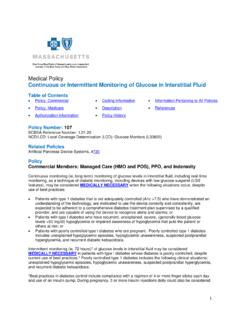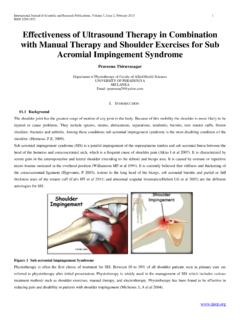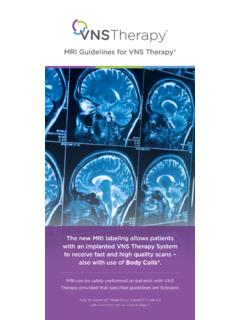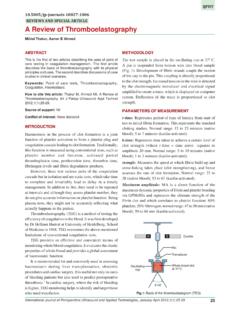Transcription of Medical Policy Magnetic Resonance‒Guided …
1 1 Medical Policy Magnetic Resonance Guided Focused ultrasound Table of Contents Policy : Commercial Coding Information Information Pertaining to All Policies Policy : Medicare Description References Authorization Information Policy History Policy Number: 243 BCBSA Reference Number: NCD/LCD: Magnetic Resonance Image Guided High Intensity Focused ultrasound (MRgFUS) for Essential Tremor (L37421) Related Policies Occlusion of Uterine Arteries Using Transcatheter Embolization #242 Radiofrequency Ablation of Miscellaneous Solid Tumors Excluding Liver Tumors #259 Policy Commercial Members: Managed Care (HMO and POS), PPO, and Indemnity Magnetic resonance imaging (MRI)-guided high-intensity ultrasound ablation may be considered MEDICALLY NECESSARY for pain palliation in adult patients with metastatic bone cancer who failed or are not candidates for radiotherapy.
2 MRI-guided high-intensity ultrasound ablation is INVESTIGATIONAL in all other situations including but not limited to: Treatment of uterine fibroids; Treatment of other tumors , brain cancer, prostate cancer and breast cancer. Medicare HMO BlueSM and Medicare PPO BlueSM Members Medical necessity criteria and coding guidance for Medicare Advantage members living in Massachusetts can be found through the link below. Local Coverage Determination (LCD): Magnetic Resonance Image Guided High Intensity Focused ultrasound (MRgFUS) for Essential Tremor (L37421) For Medical necessity criteria and coding guidance for Medicare Advantage members living outside of Massachusetts, please see the Centers for Medicare and Medicaid Services website for information regarding your specific jurisdiction at 2 Prior Authorization Information Pre-service approval is required for all inpatient services for all products.
3 See below for situations where prior authorization may be required or may not be required. Yes indicates that prior authorization is required. No indicates that prior authorization is not required. N/A indicates that this service is primarily performed in an inpatient setting. Outpatient Commercial Managed Care (HMO and POS) No Commercial PPO and Indemnity No Medicare HMO BlueSM No Medicare PPO BlueSM No CPT Codes / HCPCS Codes / ICD Codes Inclusion or exclusion of a code does not constitute or imply member coverage or provider reimbursement. Please refer to the member s contract benefits in effect at the time of service to determine coverage or non-coverage as it applies to an individual member. Providers should report all services using the most up-to-date industry-standard procedure, revenue, and diagnosis codes, including modifiers where applicable.
4 The following codes are included below for informational purposes only; this is not an all-inclusive list. The following CPT codes are considered investigational for Commercial Members: Managed Care (HMO and POS), PPO, Indemnity, Medicare HMO Blue and Medicare PPO Blue: CPT Codes CPT codes: Code Description 0071T Focused ultrasound ablation of uterine leiomyomata, including MR guidance; total leiomyomata volume less than 200 cc of tissue 0072T Focused ultrasound ablation of uterine leiomyomata, including MR guidance; total leiomyomata volume greater or equal to 200 cc of tissue The following CPT codes are considered investigational for Commercial Members: Managed Care (HMO and POS), PPO, and Indemnity: CPT Codes CPT codes: Code Description 0398T Magnetic resonance image guided high intensity focused ultrasound (mrgfus), stereotactic ablation lesion, intracranial for movement disorder including stereotactic navigation and frame placement when performed Description Magnetic resonance guided focused ultrasound (MRgFUS) is a noninvasive treatment that combines 2 technologies, focused ultrasound and Magnetic resonance imaging (MRI).
5 The ultrasound beam penetrates through the soft tissues and, using MRI for guidance and monitoring, the beam can be focused on targeted sites. ultrasound causes a local increase in temperature in the target tissue, resulting in coagulation necrosis while sparing the surrounding normal structures. ultrasound waves from each sonication are focused at a focal point that has a maximum focal volume of 20 nm in diameter and 15 nm in height/length. This causes a rapid rise in temperature (ie, to approximately 65 C-85 C), which is sufficient to achieve tissue ablation at the focal point. In addition to providing guidance, the associated MRI can provide online thermometric imaging that provides a temperature map to confirm the 3 therapeutic effect of the ablation treatment and allow for real-time adjustment of the treatment parameters.
6 The Food and Drug Administration (FDA) has approved the ExAblate MRgFUS system (InSightec, Haifa, Israel) for 2 indications: treatment of uterine fibroids (leiomyomata) and palliation of pain associated with tumors metastatic to bone. The ultrasound equipment is specifically designed to be compatible with Magnetic resonance magnets and is integrated into standard clinical MRI units. It includes a patient table, which have a cradle housing the focused ultrasound transducer in a water or light oil bath. Some models of the device have a detachable cradle; only certain cradle types can be used for palliation of pain associated with metastatic bone cancer. As noted, FDA has approved an MRgFUS for treatment of uterine fibroids, which is one of the most common conditions affecting women in the reproductive years.
7 Symptoms of uterine fibroids include menorrhagia, pelvic pressure, or pain. Several approaches are currently available to treat symptomatic uterine fibroids: hysterectomy, abdominal myomectomy, laparoscopic and hysteroscopic myomectomy, hormone therapy, uterine artery embolization, and watchful waiting. Hysterectomy and various myomectomy procedures are considered the criterion standard treatment. For treating pain associated with bone metastases, the other FDA-approved indication, the aim of MRgFUS is to destroy nerves in the bone surface surrounding the tumor. Metastatic bone disease is one of the most common causes of cancer pain. Existing treatments include conservative measures (eg, massage, exercise) and pharmacologic agents (eg, analgesics, bisphosphonates, corticosteroids).
8 For patients who fail the above treatments, standard care is use of external beam radiotherapy. However, a substantial proportion of patients have residual pain after radiotherapy, and there is a need for alternative treatments for these patients. (One option, radiofrequency ablation, is addressed in Policy #259). MRgFUS is also being investigated for treatment of other tumors, including breast, prostate, and brain tumors. Summary An integrated system providing Magnetic resonance guided focused ultrasound (MRgFUS) treatment is proposed as a noninvasive therapy for uterine fibroids and for pain palliation of bone metastases. MRgFUS is also being investigated as a treatment of other benign and malignant tumors. The evidence for MRgFUS in individuals who have uterine fibroids includes a pilot randomized controlled trial (RCT), nonrandomized comparative studies, and case series.
9 Relevant outcomes are symptoms, quality of life, resource utilization, and treatment-related morbidity. The pilot RCT (N=20 patients) reported some health outcomes, but its primary purpose was to determine the feasibility of a larger trial. It did not find statistically significant differences in quality of life outcomes between active and sham treatment groups, but it did find lower fibroid volumes after active treatment. The pivotal Food and Drug Administration trial was not randomized, the clinical significance of the primary outcome was unclear, and there were no follow-up data beyond 1 year. In the 2013 comparative study, outcomes appeared to be better with uterine artery embolization than with MRgFUS. There are insufficient data on the long-term treatment effects, recurrence rates, and impact on future fertility and pregnancy.
10 The evidence is insufficient to determine the effects of the technology on health outcomes. The evidence for MRgFUS in individuals who have metastatic bone cancer who failed or are not candidates for radiotherapy includes a sham-controlled randomized trial. Relevant outcomes are symptoms, functional outcomes, health status measures, quality of life, and treatment-related morbidity. The RCT found statistically significant improvement after MRgFUS in a composite outcome comprised of reduction in pain and morphine use, and in pain reduction as a stand-alone outcome. A substantial proportion of patients in the treatment group experienced adverse events, but most of these were not severe and were transient. The evidence is sufficient to determine qualitatively that the technology results in a meaningful improvement in the net health outcome.













